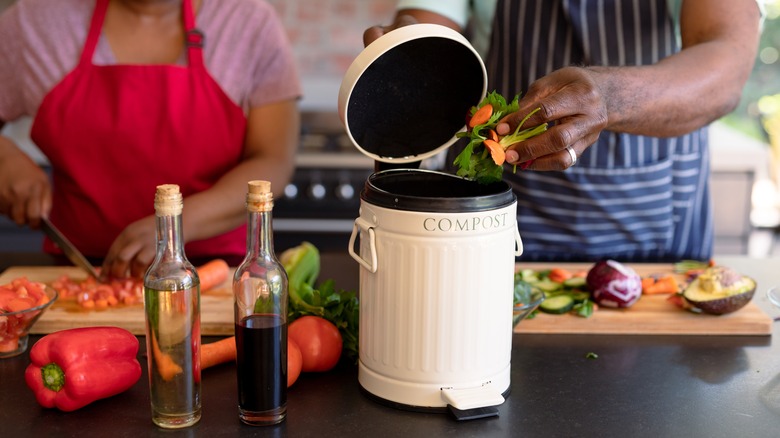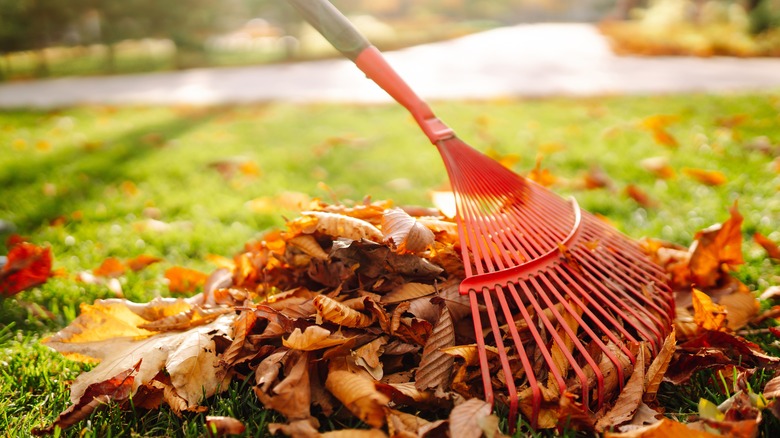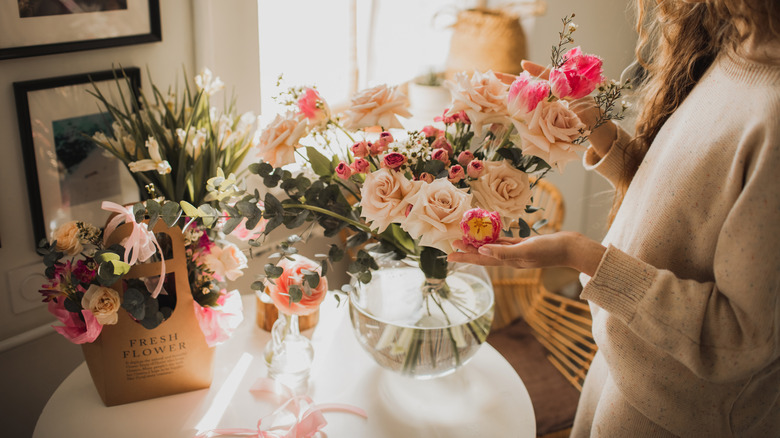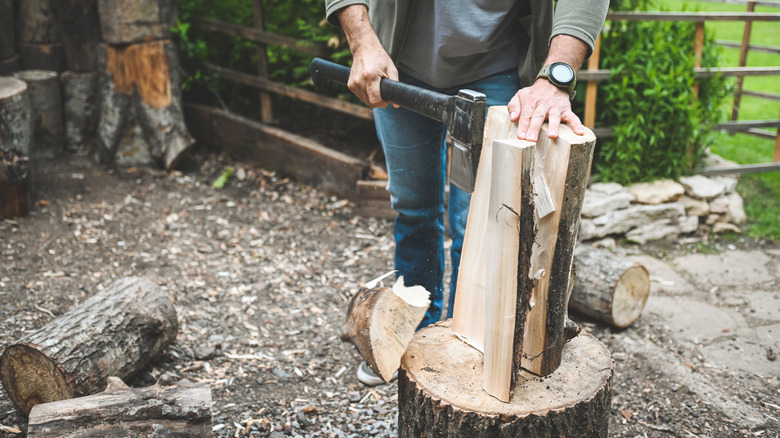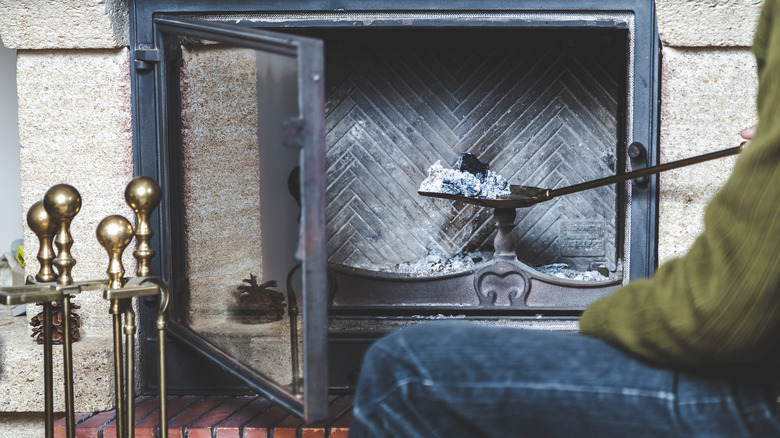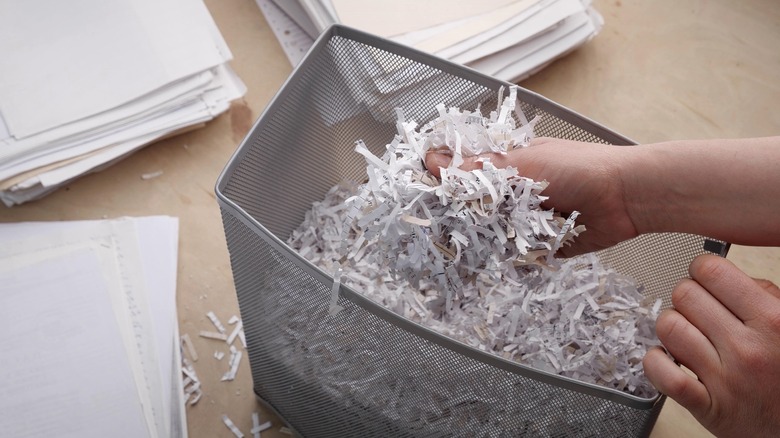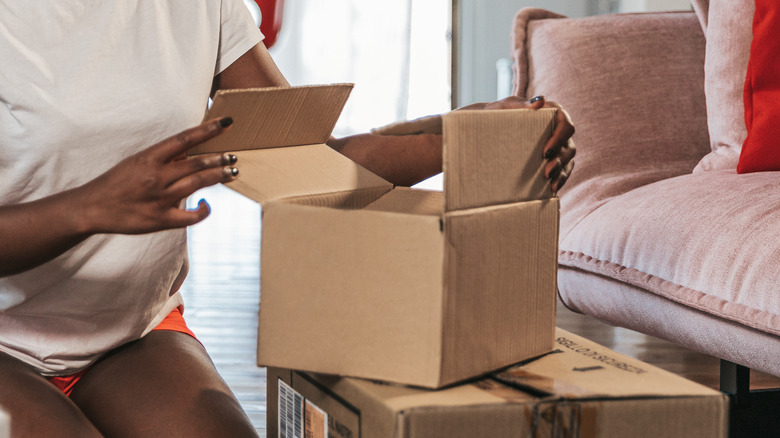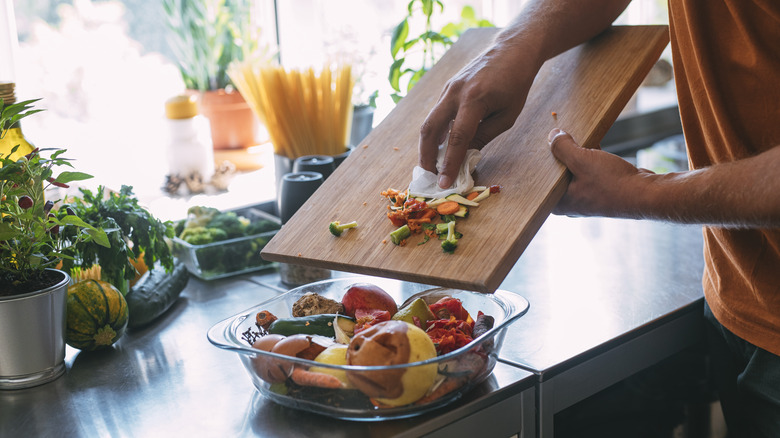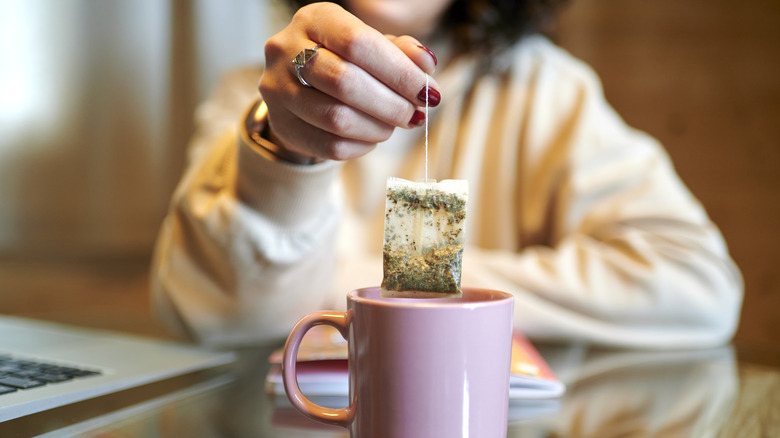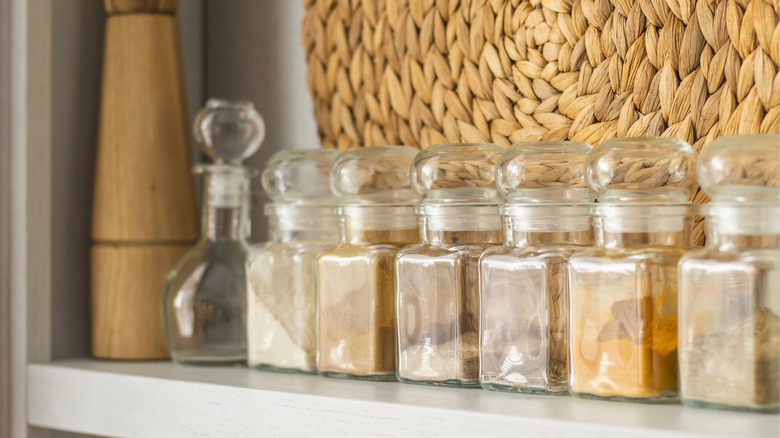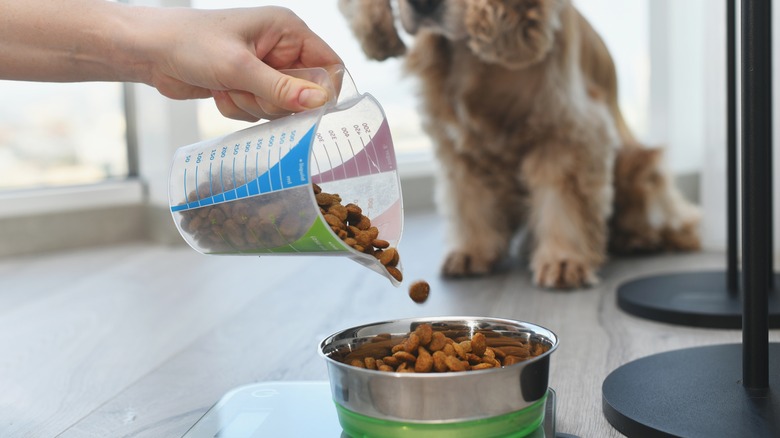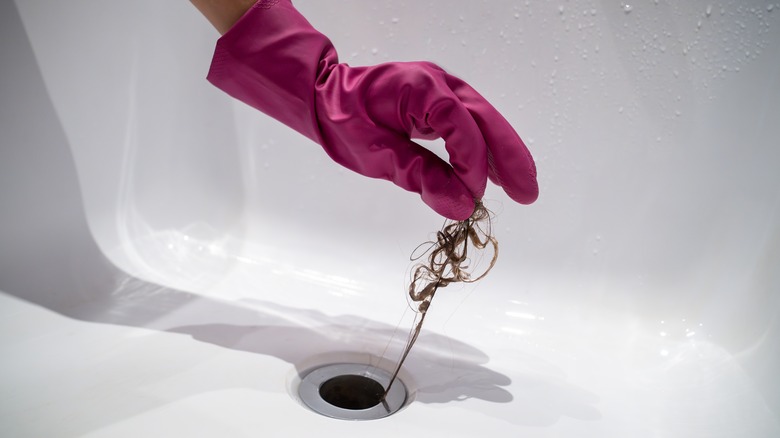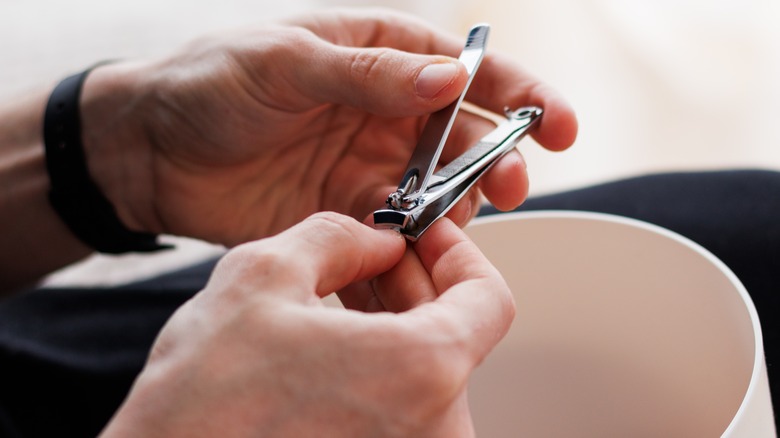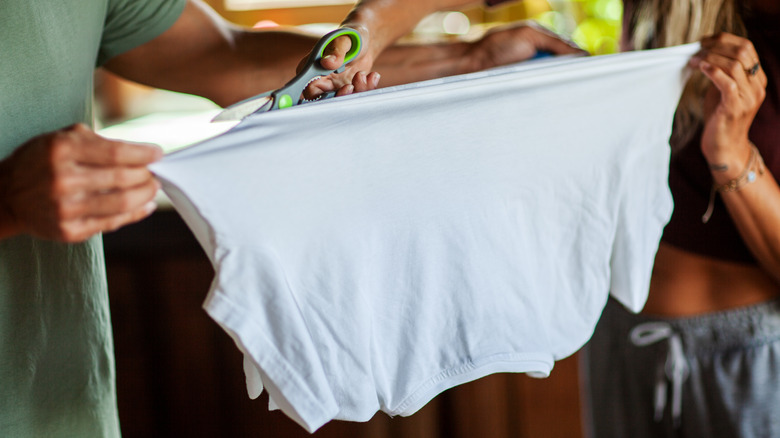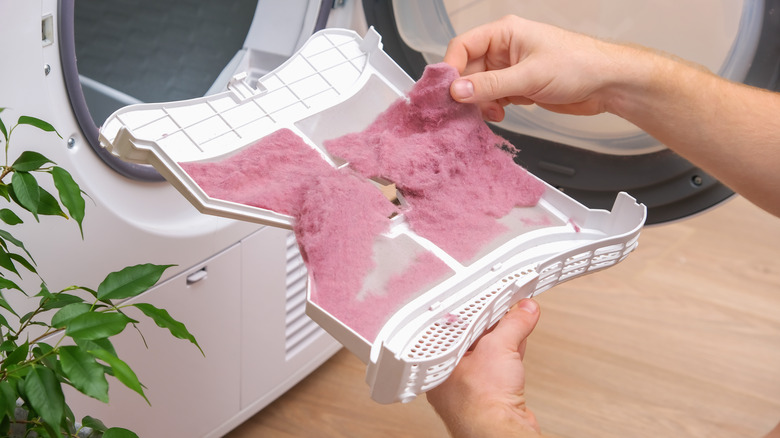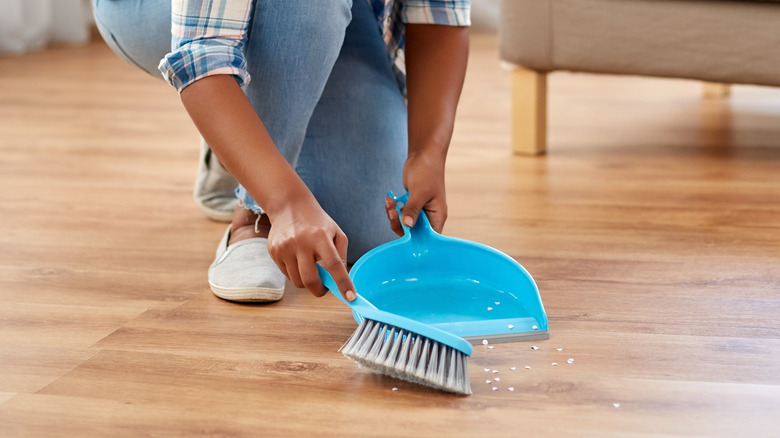15 Compost Ingredients You Likely Already Have At Home
Chances are you're throwing away a gold mine of compost ingredients. Plenty of materials that you're bagging up and sending to the landfill could be turned into free, nutrient-rich soil matter for your garden, aka "black gold." So you might want to think twice about what you do with the debris after you sweep, empty the dryer lint filter, rake leaves, groom your pet, or complete almost any other house chore. From common ingredients like food scraps to unusual additions like hair strands, we have listed 15 compostable items that you probably already have on hand.
There are many benefits of composting at home including that it reduces waste, replaces chemical fertilizers, boosts soil structure, and provides nutrients for plants. For a healthy compost pile, you need a mixture of both "green" and "brown" organic waste. Greens are nitrogen-rich materials like food scraps, while browns are carbon-rich materials like twigs. The right balance is key. Too many greens and your pile can smell rotten, but too many browns and there might not be any decomposition happening. Fortunately, you don't have to go far to get all the ingredients you need for your at-home compost.
1. Yard scraps
Your yard scraps are great carbon- and nitrogen-rich materials for your compost pile. Grass clippings, dry leaves, hedge trimmings, twigs, and similar scraps that haven't been sprayed with pesticides can go straight in the bin. Any large items like branches should be cut into small pieces to help the material break down faster. However, you don't want to include any diseased plants or invasive weeds in your stockpile. Doing so can contaminate the finished product, and instead of adding nutrients to your garden, you'll be increasing the chances for disease and weeds.
2. Flower bouquets
After your beautiful flower bouquet has wilted, you can toss it into your compost heap. Cut flowers from your garden or local florist are fine as long as they aren't sprayed with pesticides. You can even add any leftover water from the vase. However, skip pouring the liquid into your compost if it's mixed with flower feed like the plant food packets on store-bought bouquets, as they can have ingredients that kill bacteria, including the helpful organisms in your compost pile. But, homemade flower feed made from sugar can go in with the cut flowers.
3. Wood
Wood is another type of organic plant material that breaks down into helpful nutrients. It needs to be non-treated and unpainted to be compostable, so unfortunately, you can't recycle your stained wooden furniture into organic matter. Mixed wood like MDF board and plywood won't work either because it has inorganic substances like glue and formaldehyde. However, saw dust and other types of natural wood are compostable. You want to break any large wood pieces into small mulch-like chips. Since wood is carbon-rich, mix the material with nitrogen-rich greens to help it decompose.
4. Fireplace ash
Wood is even great for compost after it has been turned into ashes. If you have a wood-burning fireplace, stove, or fire pit, you can discard the ashes in your compost pile as long as the wood wasn't doused in lighter fuel. The powder has potassium that plants need. However, you don't want to add a lot, as too much ash can make your compost alkaline and it is best to keep the decaying matter neutral (not acidic or alkaline). Further, the ash should be from natural untreated wood. Remnants from bbq coals and peat aren't compostable.
5. Paper
Paper scraps can also be given new life in your compost bin. Newspapers, envelopes, receipts, paper towels, and similar materials will break down and add nutrients to the mixture, but stay away from glassy, dyed, or bleached paper. They can contain heavy metals and other non-natural materials that won't decompose. Also make sure there aren't any staples, tape, or glue on the pages. It helps the microbes break down the paper faster if they're in smaller pieces, so shred, cut, or tear the pages before mixing them into the compost pile.
6. Cardboard
Paper's cousin, cardboard, is also compostable. It is a carbon-rich brown that is great at absorbing moisture. Think egg cartons, toilet paper rolls, and storage boxes. Even pizza containers that can't be recycled can be composted, but remove the greasy parts first. However, it's better to put waxed and colored cardboard in the recycling bin and not the compost pile, as they can possibly contain inorganic material. Like with other large items, you want to cut up your cardboard into small pieces. You can also soak it in water first to make the cardboard easier to break down.
7. Food scraps
Food scraps are a common material people use in their compost bin. Products like nutshells, banana peels, corn cobs, eggshells, and stale bread are perfect for your home compost bin. They count as the green material and provide nitrogen. Scraps like eggshells and fruit pits should be crushed before going in. However, be sure to keep meat, bones, and fat out of the pile. While these animal food products are biodegradable, a backyard compost system would not reach the optimal temperature to decompose these items sufficiently. Plus, they'd rot quickly, attracting pests and releasing foul odors.
8. Tea bags and coffee grounds
Your beverage scraps can also be turned into nutrient-rich soil. Standard tea bags with the string are compostable, just make sure to remove the staple from the tea bags first. However, the majority of pyramid tea bags are not biodegradable, as they are made from a corn-derived plastic. Instead, you can cut open the pyramid bags and compost the tea leaves. Coffee is another popular beverage you can use to make your own DIY compost. The grounds and filter can be tossed in the bin, but it is best if the paper is unbleached.
9. Old spices
We've all been guilty of harboring an expired cooking spice or two in the back of the pantry. If you have a bottle that is past its prime and won't offer your dinner any flavor, you can put it in the compost bin. It is a creative way to use your expired spices and seasonings in your home while reducing waste. Simply remove the herbs from the packaging and mix it into your compost pile. You can also crush any whole spices to help them decompose faster, though this is not mandatory.
10. Pet food
You can compost wet and dry pet food, but there are some precautions. Pet food is usually protein dense, which can attract pests. It is best to compost vegetarian feed to avoid luring any critters to your home. However, you can still compost small amounts of non-vegetarian pet food in your backyard system if you mix it thoroughly with other non-food compost ingredients like leaves or cardboard. A ratio of one part pet food to three parts organic waste should do the trick. You can also compost pet treats, dog bones, and catnip.
11. Hair
Hair from you and your furry friends is steps away from being a nutritious garden treat. You can mix the hair, fur, or feathers right into your compost bin. Because these materials take a long time to decompose, you don't want to add too much to your pile. It is best to snip long pieces into short strands and break up any clumps before tossing them in. Also, make sure the hair is clean first. However, chemically treated strands, whether dyed for style or treated for fleas, don't pass the compostable test.
12. Nail clippings
Our hair isn't the only unusual item we can compost. Fingernail and toenail clippings are also an ingredient that turns into nutrient-rich fertilizer. They are a brown substance as they add carbon. Even clippings from your pets' claws can be mixed into the heap. It helps to soak the trimmings in water until they are pliable before tossing them in the bin. The pre-soak enables the trimmings to decompose faster. However, although artificial and acrylic nails may look like the real deal, they aren't an organic waste product and shouldn't be in your compost heap.
13. Old clothing
Your old t-shirt might be the key to a thriving garden. Fabrics made from natural materials like cotton, linen, wool, silk, hemp, and bamboo are biodegradable. That means old sheets, towels, clothes, and upholstery can be given new life as the microbes break them down. Just cut the fabric into small pieces before mixing it in your pile. However, you don't want to add any garments that are tarnished with non-compostable items like paint and oil or have designs printed on with ink. However, cutting out any of these non-compostable parts is an easy fix.
14. Dryer lint
When you finally remember to empty your dryer filter, think twice before tossing the lint. Depending on what's been tumbling in the machine, it can be beneficial to compost dryer lint. The collection of loose fiber, hair, and paper can be tossed in the bin as long as the fibers come from natural materials like cotton and wool. If synthetic threads like polyester or nylon are mixed in, it might be best to leave the dryer lint out. Also, if you use dryer sheets, the inorganic material can invade the lint trap, rendering it non-compostable.
15. Dust
The dirt pile in the vacuum cleaner or dustpan can be another asset for your compost. However, you want to make sure the dust pile is made of organic material. If you've just swept the kitchen, chances are the food crumbs and dead skin in the dust pan is fine. However, if you've just vacuumed a rug made from a synthetic fabric, you don't want to toss it in with your greens and browns. Once the debris checks out, sprinkle the dust into your pile. Before you know it, the fresh compost will be ready for your soil.
